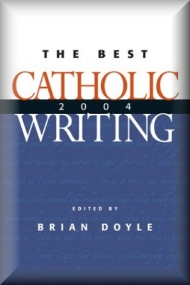
|
Posted November 19, 2004
Book: The Best Catholic 2004 Writing Editor: Brian Doyle Loyola Press, Chicago, IL, pp.228 An Excerpt from the Jacket:
Notable essays include novelist Alice McDermott’s account of her return to her childhood faith (“being Catholic is an act of rebellion”); Paul Elie’s elegy of Dorothy Day; a wry meditation on grace by Kathleen Norris; Mary Ann Glendon’s fierce anthem for the laity; John Allen’s appraisal of the papacy of John Paul II; and stern assessments of the sexual abuse crisis by Scott Appleby and Margaret O’Brien Steinfels. Other noteworthy contributors include Andrew Greeley, Murray Bodo, Paul Mariani, Lawrence Cunningham, and Dominic Grassi. An Excerpt from the Book: The Hour of the Laity Mary Ann Glendon What if the scattered Catholic faithful were to remember and embrace the heritage that is rightly theirs? What if they were to discover the newness of their faith and its power to judge the prevailing culture? What an awakening that would be for the sleeping giant! As John Paul II likes to tell young people, “If you are what you should be – that is, if you live Christianity without compromise – you will wet the world abaze!” Is it fanciful to think that the people-called-together could rediscover the dynamic newness of its faith in its dispersed condition? Members of the church’s great lay organizations around the world do not think so. Even as mobility has sapped the vitality of many parishes, there has been a great upsurge ---- mostly outside the United States thus far — in lay associations, formation programs, and ecclesial movements. These groups so varied in their charisms, so rich in storytellers, are providing a way for Catholics to stay in touch with one another and with their tradition under diaspora conditions. John Paul II has recognized the remarkable accomplishments of these groups in the area of formation and has urged his brother bishops and priests to take full advantage of the potential they afford for personal and ecclesial renewal. Until recently, I, like most American Catholics, was relatively unaware of the extent and variety of these movements. It was only through serving on the Pontifical Council for the Laity that I came to know groups like Communion and Liberation, the Community of Sant’Egidio, Focolare, the NeoCatechumenate Way, Opus Dei, and Regnum Christi and became acquainted with many of their leaders and members. What a contrast between these groups that work in harmony with the church and organizations that define their aims in terms of power! It is no surprise that the more faithful and vibrant the great lay organizations are, the more they are vilified by dissenters and anti-Catholics. But attacks do not seem to trouble them, for they know who they are and where they are going. Finally, one of the great blessing of having a papacy and a magisterium is that they help ensure that the story of the poeple-called-together will be preserved, even in the most trying times. In Vrgas Llosa’s Storyteller, an outsider comes to the dispersed Machiguengas, a man who loves the people-who-walk and their stories so much that he becomes their hablador. He is often on the road, traveling from family to family, bringing news from one place to the next, “reminding each member of the tribe that the others are alive, that despite the great distances tht separate them, they still form a community, share a tradition and beliefs, ancestors, misfortunes, and joys.” Among the many reasons to rejoice in the long pontificate of John Paul II is that, like the greatest of habladors, he has kept the story of his people radiantly alive, carrying it to every corner of the earth in one of humanity’s darkest times. |
|
